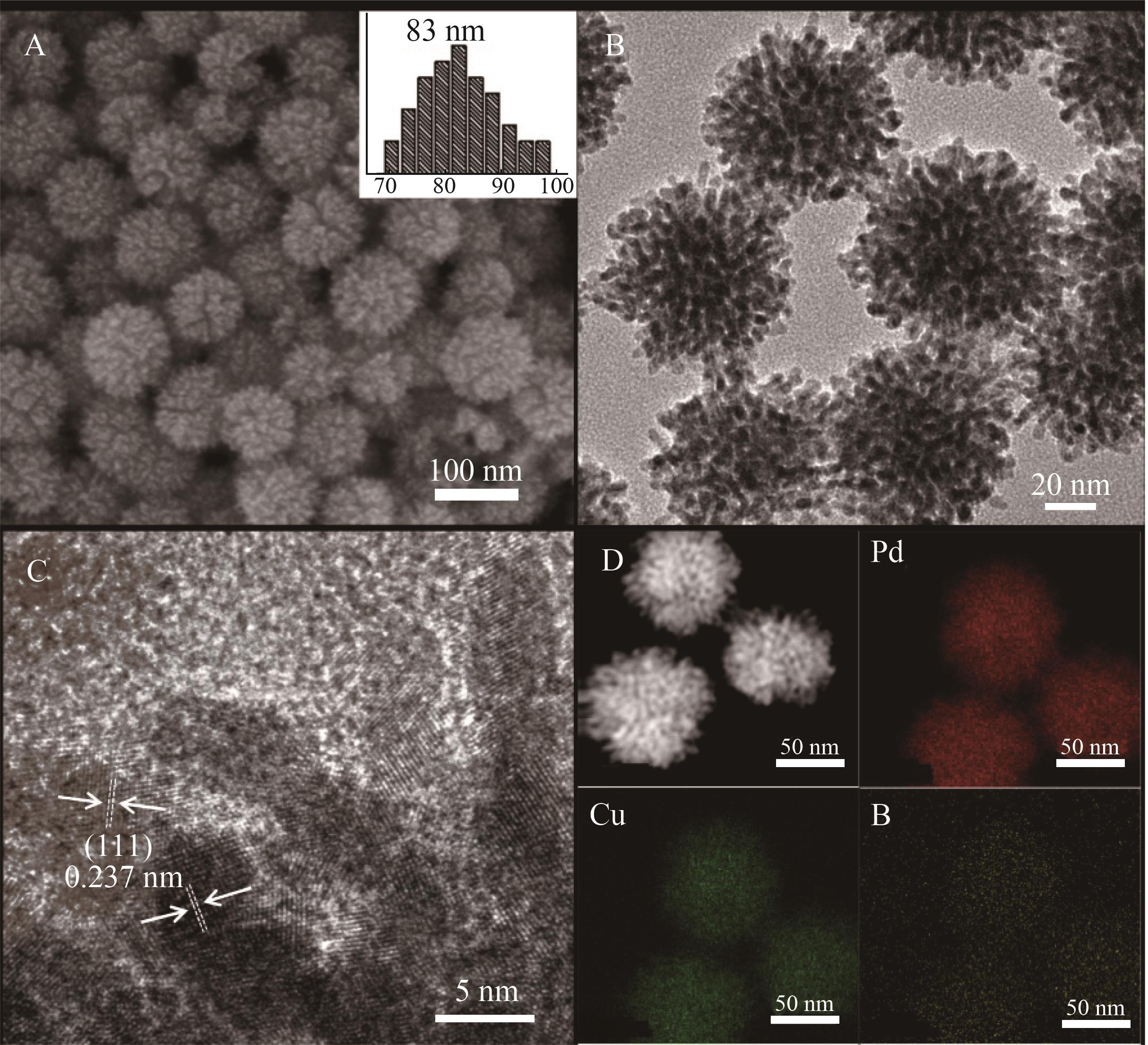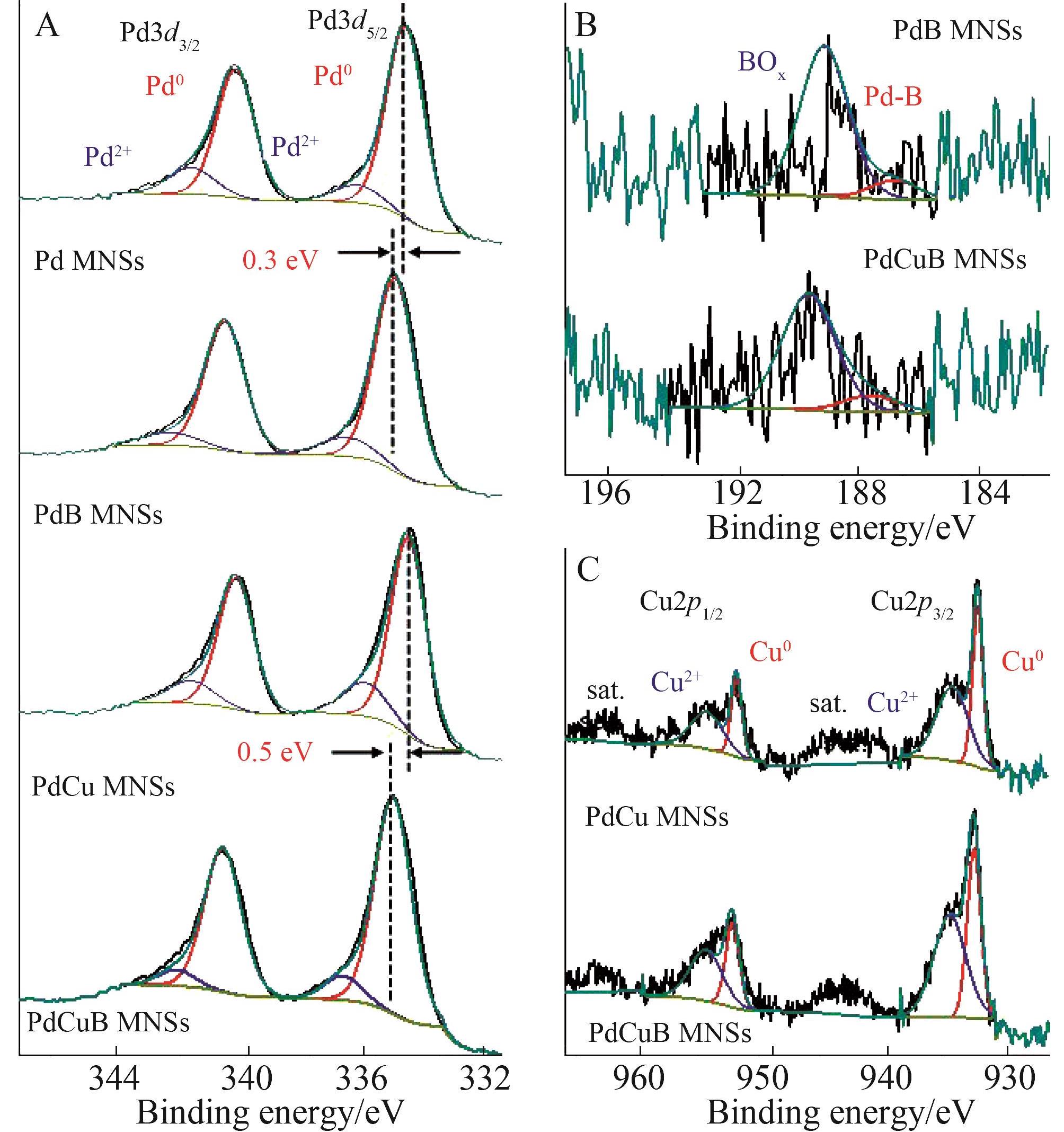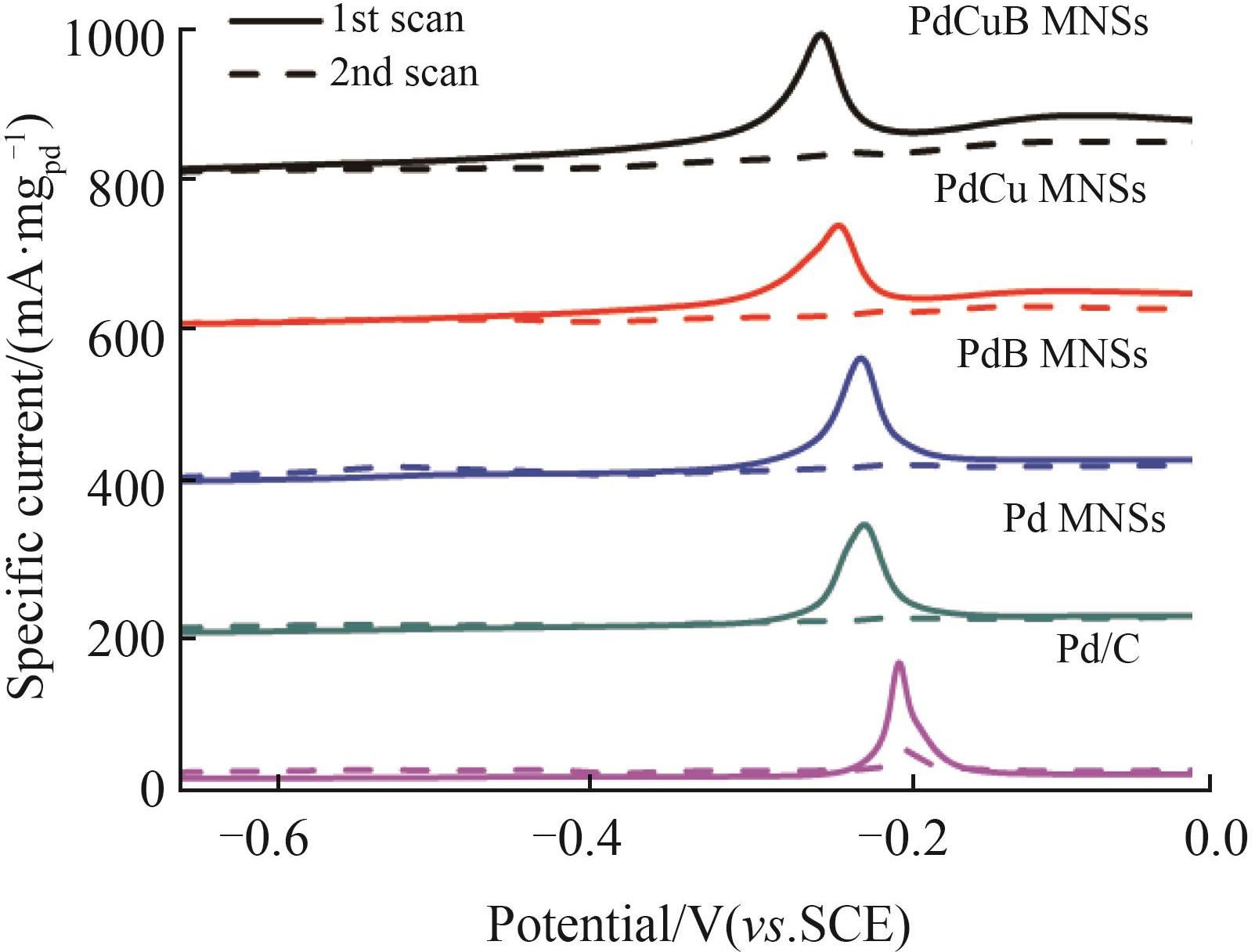
Chinese Journal of Applied Chemistry ›› 2022, Vol. 39 ›› Issue (4): 673-684.DOI: 10.19894/j.issn.1000-0518.210449
• Full Papers • Previous Articles Next Articles
Mesoporous Palladium⁃Boron Alloy Nanocatalysts: Synthesis and Performance in Methanol Oxidation Electrocatalysis
Li-Zhi SUN, Hao LYU, Xiao-Wen MIN, Ben LIU( )
)
- Key Laboratory of Green Chemistry and Technology of Ministry of Education,College of Chemistry,Sichuan University,Chengdu 610064,China
-
Received:2021-09-02Accepted:2021-12-29Published:2022-04-01Online:2022-04-19 -
Contact:Ben LIU -
About author:ben.liu@scu.edu.cn
-
Supported by:the Open Project of State Key Laboratory of Supramolecular Structure and Materials(sklssm2021011);the Fundamental Research Funds for the Central Universities
CLC Number:
Cite this article
Li-Zhi SUN, Hao LYU, Xiao-Wen MIN, Ben LIU. Mesoporous Palladium⁃Boron Alloy Nanocatalysts: Synthesis and Performance in Methanol Oxidation Electrocatalysis[J]. Chinese Journal of Applied Chemistry, 2022, 39(4): 673-684.
share this article
Add to citation manager EndNote|Ris|BibTeX
URL: http://yyhx.ciac.jl.cn/EN/10.19894/j.issn.1000-0518.210449

Fig.5 Electrochemical performance in KOH. (A) CV curves and (B) summarized ECSAs of Pd/C, Pd MNSs, PdB MNSs, PdCu MNSs and PdCuB MNSs. (C) CV curves of PdCuB MNSs collected with different scan rates. (D) Relationships between scan rates and peak specific currents of Pd/C, Pd MNSs, PdB MNSs, PdCu MNSs and PdCuB MNSs
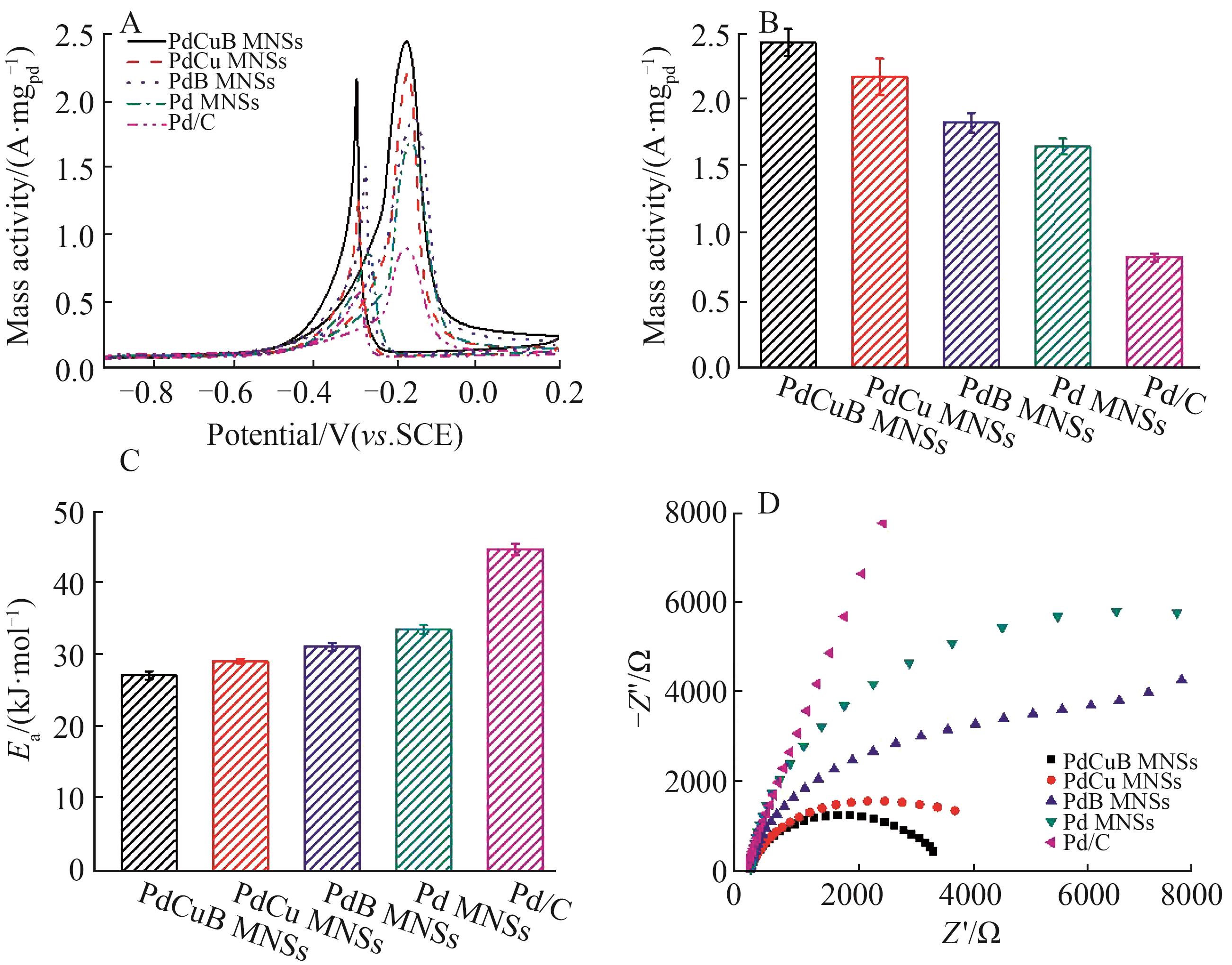
Fig.7 Electrochemical MOR performance. (A) CV curves, (B) summarized mass activities, (C) Eavalues, and (D) Nyquist plots of Pd/C, Pd MNSs, PdB MNSs, PdCu MNSs and PdCuB MNSs
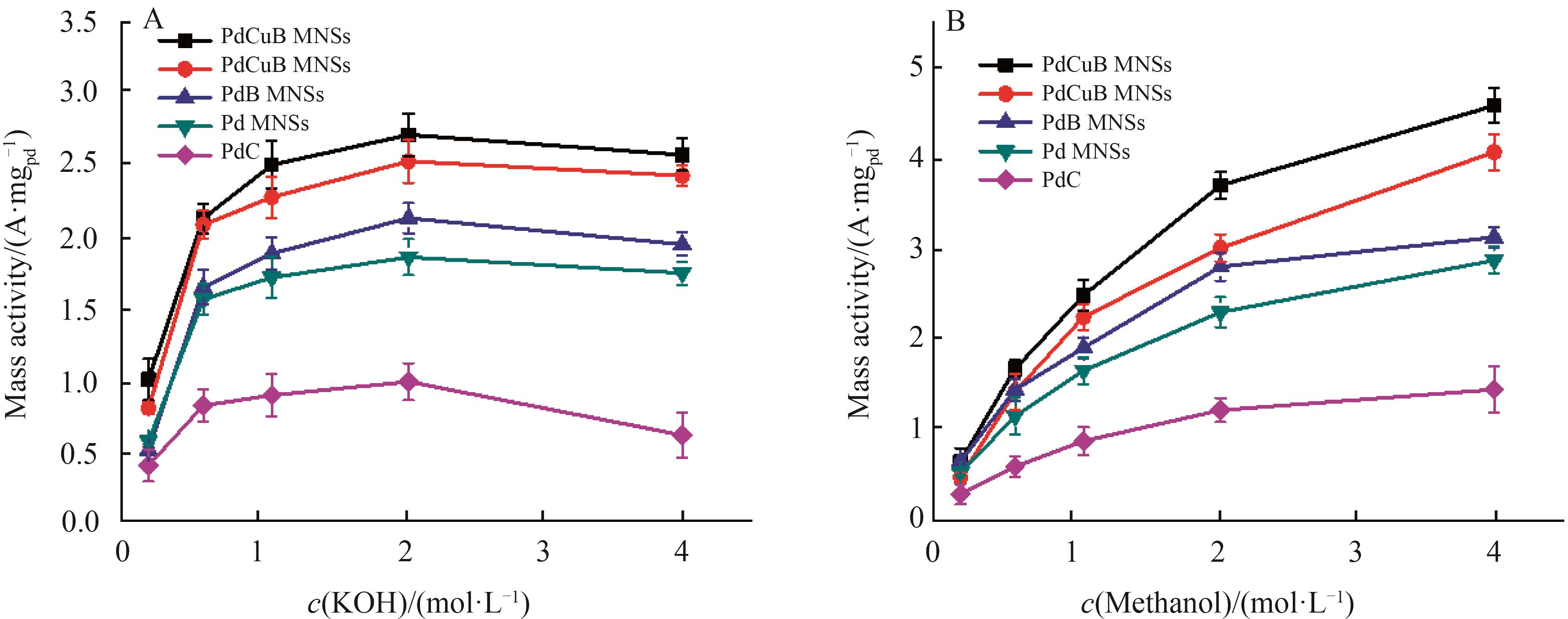
Fig.8 (A) The relationship between KOH concentrations and MOR activities of Pd/C, Pd MNSs, PdB MNSs, PdCu MNSs, and PdCuB MNSs; (B) The relationship between methanol concentrations and MOR activities of Pd/C, Pd MNSs, PdB MNSs, PdCu MNSs and PdCuB MNSs
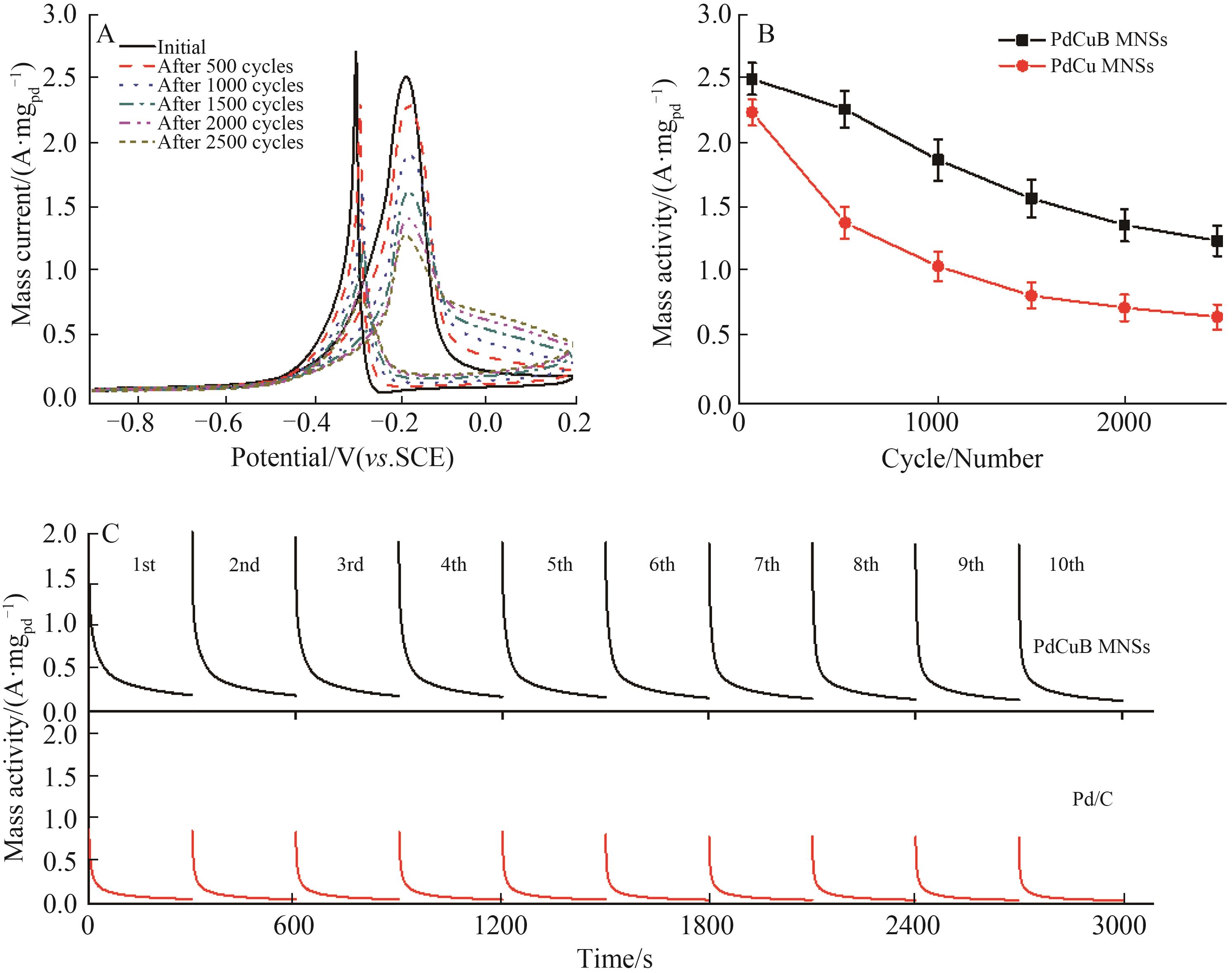
Fig.9 (A) CV curves and (B) summarized mass activities of PdCuB MNSs and PdCu MNSs during CV scans for 2500 cycles. (C) MOR i-t curves of PdCuB MNSs and Pd/C with ten test cycles
| 1 | SEH Z W, KIBSGAARD J, DICKENS C F, et al. Combining theory and experiment in electrocatalysis: insights into materials design[J]. Science, 2017, 355(6321): 146. |
| 2 | PANWAR N L, KAUSHIK S C, KOTHARI S. Role of renewable energy sources in environmental protection: a review[J]. Renew Sustainable Energy Rev, 2011, 15(3): 1513-1524. |
| 3 | YUE X, HE C, ZHONG C, et al. Fluorine-doped and partially oxidized tantalum carbides as nonprecious metal electrocatalysts for methanol oxidation reaction in acidic media[J]. Adv Mater, 2016, 28(11): 2163-2169. |
| 4 | SCOFIELD M E, KOENIGSMANN C, WANG L, et al. Tailoring the composition of ultrathin, ternary alloy PtRuFe nanowires for the methanol oxidation reaction and formic acid oxidation reaction[J]. Energy Environ Sci, 2015, 8(1): 350-363. |
| 5 | ZHAO W Y, NI B, YUAN Q, et al. Highly active and durable Pt72Ru28 porous nanoalloy assembled with sub-4.0 nm particles for methanol oxidation[J]. Adv Energy Mater, 2017, 7(8): 1601593. |
| 6 | HUANG H, YANG S, VAJTAI R, et al. Pt-decorated 3D architectures built from graphene and graphitic carbon nitride nanosheets as efficient methanol oxidation catalysts[J]. Adv Mater, 2014, 26(30): 5160-5165. |
| 7 | BORGHEI M, LEHTONEN J, LIU L, et al. Advanced biomass-derived electrocatalysts for the oxygen reduction reaction[J]. Adv Mater, 2018, 30(24): 1703691. |
| 8 | KAKATI N, MAITI J, LEE S H, et al. Anode catalysts for direct methanol fuel cells in acidic media: do we have any alternative for Pt or Pt-Ru?[J]. Chem Rev, 2014, 114(24): 12397-12429. |
| 9 | SHI X, WEN Y, GUO X, et al. Dentritic CuPtPd catalyst for enhanced electrochemical oxidation of methanol[J]. ACS Appl Mater Inter, 2017, 9(31): 25995-26000. |
| 10 | CHU Y Y, WANG Z B, JIANG Z Z, et al. A novel structural design of a Pt/C-CeO2 catalyst with improved performance for methanol electro-oxidation by beta-cyclodextrin carbonization[J]. Adv Mater, 2011, 23(27): 3100-3104. |
| 11 | DU X, LUO S, DU H, et al. Monodisperse and self-assembled Pt-Cu nanoparticles as an efficient electrocatalyst for the methanol oxidation reaction[J]. J Mater Chem A, 2016, 4(5): 1579-1585. |
| 12 | ZHANG G, YANG Z, ZHANG W, et al. Nanosized Mo-doped CeO2 enhances the electrocatalytic properties of the Pt anode catalyst in direct methanol fuel cells[J]. J Mater Chem A, 2017, 5(4): 1481-1487. |
| 13 | SHI Y, FANG Y, ZHANG G, et al. Hollow PtCu nanorings with high performance for the methanol oxidation reaction and their enhanced durability by using trace Ir[J]. J Mater Chem A, 2020, 8(7): 3795-3802. |
| 14 | 孙墨杰, 吕涛, 徐维林. 微流控合成高活性甲醇氧化碳载铂钌电催化剂[J]. 应用化学, 2018, 35(5): 564-573. |
| SUN M J, LÜ T, XU W L. Microfluidic synthesis of high-activity PtRu/C catalyst for methanol electro-oxidation[J]. Chinese J Appl Chem, 2018, 35(5): 564-573. | |
| 15 | 黄火娣, 张晓凤, 张艺, 等. 铂/{还原氧化石墨烯/硅钨酸盐}n 复合物的制备及其电催化性能[J]. 应用化学, 2017, 34(10): 1209-1220. |
| HUANG H D, ZHANG X F, ZHANG Y, et al. Synthesis of Pt/{reduced graphene oxide/polyoxometalates}n composite films and their electrocatalytic performance[J]. Chinese J Appl Chem, 2017, 34(10): 1209-1220. | |
| 16 | SHAMRAIZ U, RAZA B, ULLAH S, et al. Low cost efficient Sr(OH)2 promoted Pd/rGO electrocatalyst for direct alcohol fuel cell[J]. Appl Surf Sci, 2020, 507: 145022. |
| 17 | 牛凤娟, 易清风. 纳米钯催化剂对甲醇的电催化氧化[J]. 电化学, 2011, 17(1): 67-72. |
| NIU F J,YI Q F. A titanium-supported nanoporous Pd electrocatalyst for methanol oxidation. electrochemistry[J]. 2011, 17(1): 67-72. | |
| 18 | 魏子栋, 李兰兰, 李莉, 等. 甲醇电化学催化氧化机理研究进展[J]. 化学通报, 2004, 67(1): 9-14. |
| WEI Z D, LI L L, LI L, et al. Mechanism of methanol oxidation on electrocatalysts[J]. Chin Chem Bull, 2004, 67(1): 9-14. | |
| 19 | LV H, LOPES A, XU D, et al. Multimetallic hollow mesoporous nanospheres with synergistically structural and compositional effects for highly efficient ethanol electrooxidation[J]. ACS Cent Sci, 2018, 4(10): 1412-1419. |
| 20 | DEBE M K. Electrocatalyst approaches and challenges for automotive fuel cells[J]. Nature, 2012, 486(7401): 43-51. |
| 21 | WANG D, XIN H L, HOVDEN R, et al. Structurally ordered intermetallic platinum-cobalt core-shell nanoparticles with enhanced activity and stability as oxygen reduction electrocatalysts[J]. Nat Mater, 2013, 12(1): 81-87. |
| 22 | LI C, XU Y, DENG K, et al. Metal-nonmetal nanoarchitectures: quaternary PtPdNiP mesoporous nanospheres for enhanced oxygen reduction electrocatalysis[J]. J Mater Chem A, 2019, 7(8): 3910-3916. |
| 23 | YOO J S, ZHAO Z J, NØRSKOV J K, et al. Effect of boron modifications of palladium catalysts for the production of hydrogen from formic acid[J]. ACS Catal, 2015, 5(11): 6579-6586. |
| 24 | KOBAYASHI K, KOBAYASHI H, MAESATO M, et al. Discovery of hexagonal structured Pd-B nanocrystals[J]. Angew Chem Int Ed, 2017, 56(23): 6578-6582. |
| 25 | LV H, SUN L, XU D, et al. Ternary metal-metalloid-nonmetal alloy nanowires: a novel electrocatalyst for highly efficient ethanol oxidation electrocatalysis[J]. Sci Bull, 2020, 65(21): 1823-1831. |
| 26 | WANG T, LI F, HUANG H, et al. Porous Pd-PdO nanotubes for methanol electrooxidation[J]. Adv Funct Mater, 2020, 30(21): 2000534. |
| 27 | ZHU J, CHEN S, XUE Q, et al. Hierarchical porous Rh nanosheets for methanol oxidation reaction[J]. Appl Catal B: Environ, 2020, 264: 118520. |
| 28 | LV H, SUN L, XU D, et al. Mesoporous palladium-boron alloy nanospheres[J]. J Mater Chem A, 2019, 7(43): 24877-24883. |
| 29 | LV H, XU D, SUN L, et al. Ternary palladium-boron-phosphorus alloy mesoporous nanospheres for highly efficient electrocatalysis[J]. ACS Nano, 2019, 13(10): 12052-12061. |
| 30 | SUN L, LV H, XU D, et al. Asymmetric PdPtCu mesoporous hemispheres on nitrogen-functionalized graphene for methanol oxidation electrocatalysis[J]. J Mater Chem A, 2020, 8(31): 15706-15714. |
| 31 | LV H, LV F, QIN H, et al. Single-crystalline mesoporous palladium and palladium-copper nanocubes for highly efficient electrochemical CO2 reduction[J]. CCS Chem, 2021: 1435-1444. |
| 32 | ZHU C, SHI Q, FU S, et al. Efficient synthesis of MCu (M=Pd, Pt, and Au) aerogels with accelerated gelation kinetics and their high electrocatalytic activity[J]. Adv Mater, 2016, 28(39): 8779-8783. |
| 33 | LI J, CHEN J, WANG Q, et al. Controllable increase of boron content in B-Pd interstitial nanoalloy to boost the oxygen reduction activity of palladium[J]. Chem Mater, 2017, 29(23): 10060-10067. |
| 34 | SUN L, LV H, WANG Y, et al. Unveiling synergistic effects of interstitial boron in palladium-based nanocatalysts for ethanol oxidation electrocatalysis[J]. J Phys Chem Lett, 2020, 11 (16): 6632-6639. |
| 35 | JIANG K, XU K, ZOU S, et al. B-doped Pd catalyst: boosting room-temperature hydrogen production from formic acid-formate solutions[J]. J Am Chem Soc, 2014, 136(13): 4861-4864. |
| 36 | JIANG B, ZHANG X G, JIANG K, et al. Boosting formate production in electrocatalytic CO2 reduction over wide potential window on Pd surfaces[J]. J Am Chem Soc, 2018, 140(8): 2880-2889. |
| 37 | VO DOAN T T, WANG J, POON K C, et al. Theoretical modelling and facile synthesis of a highly active boron-doped palladium catalyst for the oxygen reduction reaction[J]. Angew Chem Int Ed, 2016, 55(24): 6842-6847. |
| 38 | CHEN L, LIANG X, LI X, et al. Promoting electrocatalytic methanol oxidation of platinum nanoparticles by cerium modification[J]. Nano Energy, 2020, 73: 104784. |
| 39 | NGUYEN S T, LAW H M, NGUYEN H T, et al. Enhancement effect of Ag for Pd/C towards the ethanol electro-oxidation in alkaline media[J]. Appl Catal B: Environ, 2009, 91(1/2): 507-515. |
| 40 | CHEN L, LU L, ZHU H, et al. Improved ethanol electrooxidation performance by shortening Pd-Ni active site distance in Pd-Ni-P nanocatalysts[J]. Nat Commun, 2017, 8: 14136. |
| 41 | HONG J W, KIM Y, WI D H, et al. Ultrathin free-standing ternary-alloy nanosheets[J]. Angew Chem Int Ed, 2016, 55(8): 2753-2758. |
| 42 | LIANG W, WANG Y, ZHAO L, et al. 3D anisotropic Au@Pt-Pd hemispherical nanostructures as efficient electrocatalysts for methanol, ethanol, and formic acid oxidation reaction[J]. Adv Mater, 2021, 33(30): 2100713. |
| 43 | XU H, SHANG H, WANG C, et al. Recent progress of ultrathin 2D Pd-based nanomaterials for fuel cell electrocatalysis[J]. Small, 2021, 17(5): 2005092. |
| 44 | WANG T, SUN H, XUE Q, et al. Holey platinum nanotubes for ethanol electrochemical reforming in aqueous solution[J]. Sci Bull, 2021, 66(20): 2079-2089. |
| [1] | Hai-Xiang XIU, Wan-Qiang LIU, Dong-Ming YIN, Yong CHENG, Chun-Li WANG, Li-Min WANG. Research Progress of AB2 Laves Phase Hydrogen Storage Alloys [J]. Chinese Journal of Applied Chemistry, 2023, 40(5): 640-652. |
| [2] | Chao ZHANG. Research Prospect of Single Atom Catalysts Towards Electrocatalytic Reduction of Carbon Dioxide [J]. Chinese Journal of Applied Chemistry, 2022, 39(6): 871-887. |
| [3] | Yan WANG, Shu-Cong ZHANG, Xing-Kun WANG, Zhi-Cheng LIU, Huan-Lei WANG, Ming-Hua HUANG. Research Progress on Transition Metal⁃Based Catalysts for Hydrogen Evolution Reaction via Seawater Electrolysis [J]. Chinese Journal of Applied Chemistry, 2022, 39(6): 927-940. |
| [4] | Lin-Jie SHANG, Jiang LIU, Ya-Qian LAN. Covalent Organic Framework Materials for Photo/ Electrocatalytic Carbon Dioxide Reduction [J]. Chinese Journal of Applied Chemistry, 2022, 39(4): 559-584. |
| [5] | Li-Jun WU, Shou-Jie GUO, Chao ZHANG, Zhi-Sheng LI, Wei-Cong LI, Chang-Chun YANG. In⁃situ Electrochemical Preparation of Li⁃Na Alloy and the Co⁃storage of Li+ and Na+ Ions [J]. Chinese Journal of Applied Chemistry, 2022, 39(11): 1757-1765. |
| [6] | CHENG Guang-Zeng, LIU Shuai, WANG Huan-Lei. Potential High-Performance Anode Material for Potassium Ion Batteries:Antimony [J]. Chinese Journal of Applied Chemistry, 2021, 38(2): 170-180. |
| [7] | BI Yipiao, GONG Xue, YANG Fa, RUAN Mingbo, SONG Ping, XU Weilin. Polyvalent MnOx/C Electrocatalyst for Highly Efficient Nitrogen Reduction Reaction [J]. Chinese Journal of Applied Chemistry, 2020, 37(9): 1048-1055. |
| [8] | MENG Yang, YANG Chan, PENG Juan. Progress in Iron, Cobalt and Nickel-Based Metal Phosphide Nano-catalysts for Hydrogen Production under Alkaline Conditions [J]. Chinese Journal of Applied Chemistry, 2020, 37(7): 733-745. |
| [9] | CHEN Jiaqi, ZHOU Yan, SUN Jingwen, ZHU Junwu, WANG Xin, FU Yongsheng. Recent Progress of Metal Organic Frameworks-Based Hollow Materials [J]. Chinese Journal of Applied Chemistry, 2020, 37(11): 1221-1235. |
| [10] | CHE Tinghua, TAN Xiao, YAN Jiawei, SONG Fengdan, ZHANG Hongmei, QI Suitao. Synthesis of Copper Modified Porous Nickel Self-supported Electrode and Its Catalytic Oxidation of Glucose [J]. Chinese Journal of Applied Chemistry, 2019, 36(9): 1091-1098. |
| [11] | LI Xinjie,XU He,YU Mei,ZHANG Chao,GUO Anru,LIU Chang. Nitrogen-Doped Graphitic Carbon Coated Cobalt Nanocatalysts for Highly Efficient and Durable Hydrogen Evolution Reaction [J]. Chinese Journal of Applied Chemistry, 2019, 36(5): 571-577. |
| [12] | LI Xinjie, XU He, YU Mei, ZHANG Chao, GUO Anru, LIU Chang. Nitrogen-Doped Graphitic Carbon Coated Cobalt Nanocatalysts for Highly Efficient and Durable Hydrogen Evolution Reaction [J]. Chinese Journal of Applied Chemistry, 2019, 36(5): 0-0. |
| [13] | LONG Xia,WANG Yaqiong,JU Min,WANG Zheng,YANG Shihe. Elaboration and Application of Transition Metals Based Layered Double Hydroxides for Electrochemical Water Oxidation [J]. Chinese Journal of Applied Chemistry, 2018, 35(8): 881-889. |
| [14] | Xiaodong NIU, Wei SUN, Xin QIU, Deping ZHANG, Zheng TIAN, Jian MENG. Advances and Future Developments in Preparation of Mg-RE Alloys by Molten Salt Electrochemical Process [J]. Chinese Journal of Applied Chemistry, 2018, 35(4): 381-393. |
| [15] | CHEN Si,SUN Lizhen,SHU Xinxin,ZHANG Jintao. Graphene-based Catalysts for Efficient Electrocatalytic Applications [J]. Chinese Journal of Applied Chemistry, 2018, 35(3): 272-285. |
| Viewed | ||||||
|
Full text |
|
|||||
|
Abstract |
|
|||||

